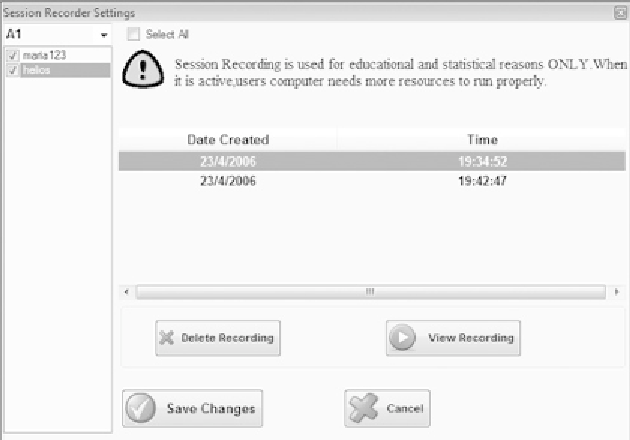Information Technology Reference
In-Depth Information
Figure 7. Screenshot: Session recorder settings
extra information. Instructors can filter these data
by date, user or service and then export it to a.csv
file, for further processing outside the platform.
Good practice suggests analyzing these data with
the use of a graphical tool. A further analysis of log
data could lead to results like LOs usage, service
usage and user's preferences in LOs and activities.
exposed to the network and are made available
to the rest of the organization's infrastructure.
In order for people to be able to choose the
right course for them, a global search engine
could be used for all supported LMSs. This search
engine could be used not only for searching with
keywords for courses but for searching with terms
like cognitive level, difficulty level, discipline
area, etc. This would be a great improvement for
people seeking for lifelong learning opportunities
since all this information will not be scattered
around, but gathered and presented by a search
engine where it is easily accessed. This of course
requires the use of compatible metadata from all
LMSs taking part and the exposure of the neces-
sary information.
As with any other software, Diplek needs to
keep up with the rapid developments in the field of
modern ICT. The current version of Diplek enables
instructors to maintain an easy to use learning
environment for their learners' by customizing
the course presentations and platform services
according to each users needs. This customization
is currently done by hand. In a future version of
FUTURE RESEARCH DIRECTIONS
LMSs have risen above the early expectations of
being just a trend in education to become a major
part of the so-called educational revolution. The
deployment of a LMS in an organization should
be done in respect to the existing infrastructure. It
is more important to have a learning platform that
smoothly integrates with all other organization's
supporting tools (Customer Relation Management
tools, Enterprise and Resource Management tools,
etc.) rather than having an isolated LMS on the
organization's network. This could be achieved by
using a Service Oriented Architecture for develop-
ing LMSs where only the necessary services are

Search WWH ::

Custom Search